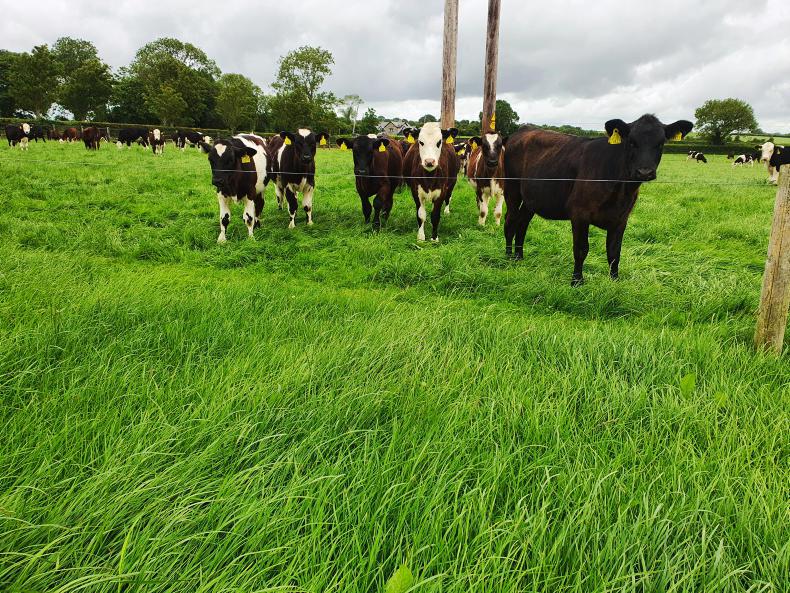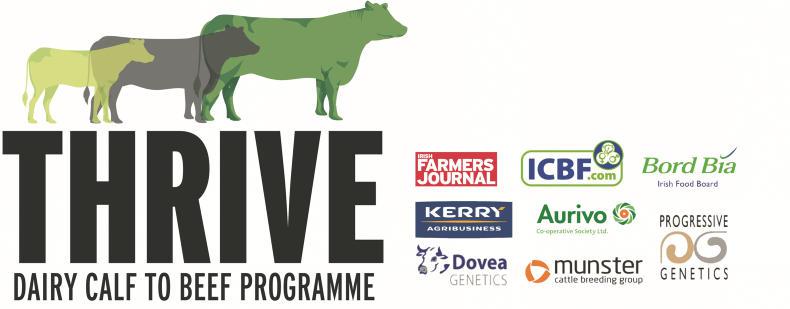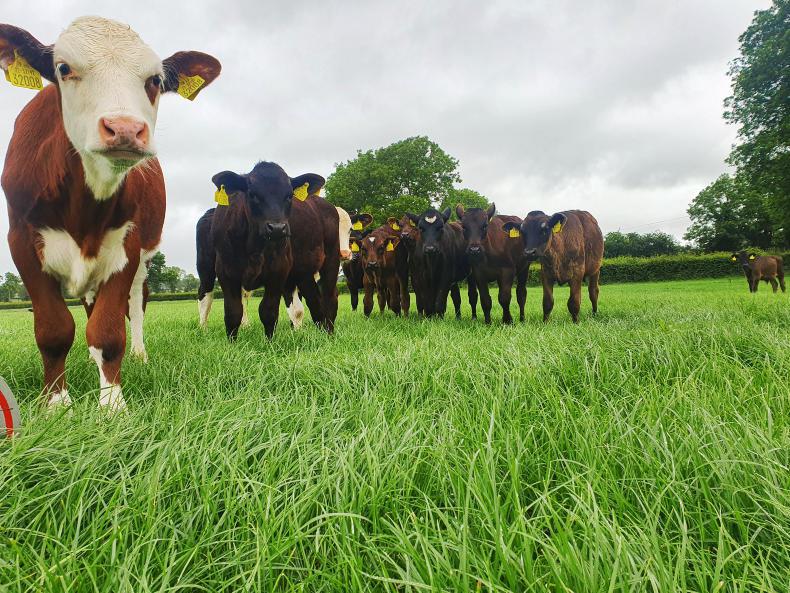Every year, the Thrive programme farmers seem to debate the feeding of calves throughout the summer months.
Where in the past, personally I would have been in the ‘no need for meal when grass quality is good’ camp, things no longer seem so black and white.
Take the case of the Thrive demo farm for example.
Meal or no meal
Last year, we decided to cease meal feeding to the strongest batches of calves in late June and not reintroduce it until early September.
However, the lightest 40 calves continued to get 1kg/day concentrate throughout the summer months.
The thinking behind this was that in a system where we want to get as many animals slaughtered off grass at the end of the second grazing season as possible, we need to hit a housing weight for the first winter of around 240kg.
The only way this was going to happen was if daily liveweight gain of the entire group of calves averaged 0.9kg/day over the summer months.
While that may not sound like a massive daily gain, there are those calves that would struggle to achieve it, even where grassland is well managed.
This is especially true for younger, lighter calves that do not have the grass intake capacity to support such gains.
Liveweight performance
As expected, the calves that were meal fed for this period outperformed the grass-only group by almost 300g/day (1.02kg/day versus 0.75kg/day).
However, from the time of meal being reintroduced to all calves in early September through to housing in early November, the calves that had gotten no meal during the summer then compensated and grew faster up to housing (0.72kg/day v 1.11kg/day).

On the demo farm, calves need to average 0.9kg/day for the first season at grass to achieve a housing weight of around 240kg.
Interestingly, both groups performed similarly over the winter period at 0.83kg/day and 0.89kg/day for the summer meal fed and no summer meal groups respectively.
Comparison
It is hard and indeed unfair to compare the two groups on an actual liveweight basis, as the calves that were supplemented all summer were the lightest calves.
If the lightest calves received no meal for this period, would they still have performed as well as the older heavier calves? Probably not.
Would we have got an extra 300g/day from supplementing the oldest calves with 1kg/day during the summer?
Again, I would assume that, yes, there would have been a response to meal feeding, but not as much as 300g/day.

On the demo farm, calves need to average 0.9kg/day for the first season at grass to achieve a housing weight of around 240kg.
One thing that we are sure of is that feeding the lightest calves brought up the average housing weight and, more importantly, tightened the weight spread across the entire batch of 140 cattle. This made housing for winter a much easier task.
At this stage, these cattle are about to start their finishing period.
Compared to the previous year, cattle are around 15kg heavier than at the same point last year.
At least some of this gain can be attributed to bringing up the average weight of the lightest calves last summer at grass.
Tips for meal feeding
To sum up, the current thinking in the programme re: feeding meal all summer, the following points must be considered.
Where calves are thriving well and are on target weight wise, meal feeding can be stopped for the next six weeks or so.However, where cattle are to be finished off grass at 19 months old, feeding 1kg meal now will help achieve an earlier finishing date and so lifetime meal feeding may not increase at all. Lighter calves or later-born calves will benefit from a continuation of 1kg/day meal being fed. In this case, above 300g/day divided by 30c/kg meal gives a cost of €1/kg liveweight. Where grassland management is not top class, meal feeding can help compensate for this.Feeding meal every day is a good way of herding cattle and makes it easier to identify sick animals if they don’t come to feed. If meal feeding is stopped, time still needs to be spent with stock every day.Feeding 1kg meal should be sufficient in the vast majority of cases. Feeding above this rate will result in the law of diminishing returns, with each additional kilo of meal delivering less liveweight gain.If weather conditions were to deteriorate, meal feeding should be reintroduced to maintain performance.
Every year, the Thrive programme farmers seem to debate the feeding of calves throughout the summer months.
Where in the past, personally I would have been in the ‘no need for meal when grass quality is good’ camp, things no longer seem so black and white.
Take the case of the Thrive demo farm for example.
Meal or no meal
Last year, we decided to cease meal feeding to the strongest batches of calves in late June and not reintroduce it until early September.
However, the lightest 40 calves continued to get 1kg/day concentrate throughout the summer months.
The thinking behind this was that in a system where we want to get as many animals slaughtered off grass at the end of the second grazing season as possible, we need to hit a housing weight for the first winter of around 240kg.
The only way this was going to happen was if daily liveweight gain of the entire group of calves averaged 0.9kg/day over the summer months.
While that may not sound like a massive daily gain, there are those calves that would struggle to achieve it, even where grassland is well managed.
This is especially true for younger, lighter calves that do not have the grass intake capacity to support such gains.
Liveweight performance
As expected, the calves that were meal fed for this period outperformed the grass-only group by almost 300g/day (1.02kg/day versus 0.75kg/day).
However, from the time of meal being reintroduced to all calves in early September through to housing in early November, the calves that had gotten no meal during the summer then compensated and grew faster up to housing (0.72kg/day v 1.11kg/day).

On the demo farm, calves need to average 0.9kg/day for the first season at grass to achieve a housing weight of around 240kg.
Interestingly, both groups performed similarly over the winter period at 0.83kg/day and 0.89kg/day for the summer meal fed and no summer meal groups respectively.
Comparison
It is hard and indeed unfair to compare the two groups on an actual liveweight basis, as the calves that were supplemented all summer were the lightest calves.
If the lightest calves received no meal for this period, would they still have performed as well as the older heavier calves? Probably not.
Would we have got an extra 300g/day from supplementing the oldest calves with 1kg/day during the summer?
Again, I would assume that, yes, there would have been a response to meal feeding, but not as much as 300g/day.

On the demo farm, calves need to average 0.9kg/day for the first season at grass to achieve a housing weight of around 240kg.
One thing that we are sure of is that feeding the lightest calves brought up the average housing weight and, more importantly, tightened the weight spread across the entire batch of 140 cattle. This made housing for winter a much easier task.
At this stage, these cattle are about to start their finishing period.
Compared to the previous year, cattle are around 15kg heavier than at the same point last year.
At least some of this gain can be attributed to bringing up the average weight of the lightest calves last summer at grass.
Tips for meal feeding
To sum up, the current thinking in the programme re: feeding meal all summer, the following points must be considered.
Where calves are thriving well and are on target weight wise, meal feeding can be stopped for the next six weeks or so.However, where cattle are to be finished off grass at 19 months old, feeding 1kg meal now will help achieve an earlier finishing date and so lifetime meal feeding may not increase at all. Lighter calves or later-born calves will benefit from a continuation of 1kg/day meal being fed. In this case, above 300g/day divided by 30c/kg meal gives a cost of €1/kg liveweight. Where grassland management is not top class, meal feeding can help compensate for this.Feeding meal every day is a good way of herding cattle and makes it easier to identify sick animals if they don’t come to feed. If meal feeding is stopped, time still needs to be spent with stock every day.Feeding 1kg meal should be sufficient in the vast majority of cases. Feeding above this rate will result in the law of diminishing returns, with each additional kilo of meal delivering less liveweight gain.If weather conditions were to deteriorate, meal feeding should be reintroduced to maintain performance.









 This is a subscriber-only article
This is a subscriber-only article












SHARING OPTIONS: